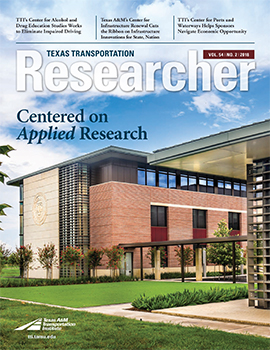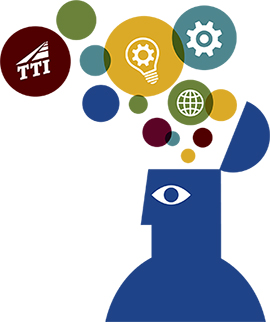
When I was assistant secretary for research and technology at the U.S. Department of Transportation, part of my job was to review proposals for the federal University Transportation Center grant program.
What I learned in that process is that a university-based center brings a number of unique strengths to the table: fresh ideas from the dynamic mix of practical and theoretical professionals, a natural outcome of the university environment; a matrixed research approach from multiple academic disciplines where the center is housed; and the freedom to think beyond a specific problem statement to the bigger picture of transportation issues.
It is important to note, however, that states also have an incentive to work with the academic community for innovation and solutions to challenges. The Texas A&M Transportation Institute (TTI) is home to five centers funded by the state of Texas. You’ve likely read their stories in this issue of the Texas Transportation Researcher already, so I won’t list them all here. But each of them shares those characteristics I just mentioned.
TTI’s Center for Transportation Safety (CTS), established in 2001, is a good example of how Institute thought leadership directs the discussion in Texas and beyond, in this case on the vital topic of transportation safety. As part of the Bloomberg Government’s Next. series, I recently spoke on the challenges of human-technology interaction we’ll face as connected-automated vehicles (CAVs) arrive in the coming decades. The unpredictability of human behavior and how to program CAVs to account for that might just be the most significant technological challenge of our lifetime. CTS is leading the TTI team recently selected by the National Highway Traffic Safety Administration for an indefinite delivery indefinite quantity contract to evaluate how vehicle-based systems affect driver behavior and performance. At the state level, center experts are helping the Texas Department of Transportation implement its Strategic Highway Safety Plan through an initiative titled Texas Together on the Road to Zero, which includes regional transportation safety workshops facilitated by CTS experts.
The Trump Administration has stated its commitment to update and upgrade U.S. transportation infrastructure. Yet there are less public funds to do that, so we have to figure out a way to do it smarter, more cost-effectively, and with longer-lasting results. That’s the mission of the Center for Infrastructure Renewal (CIR), which held its ribbon cutting on April 11. The center represents a landmark of public-private cooperation never before seen in our country. TTI is partnering with the Texas A&M Engineering Experiment Station to manage CIR, which is more than merely a research center — it’s a hub of forward-thinking exploration, analysis and testing that promises best-of-their-kind innovations to strengthen our nation’s infrastructure.
Cross-cutting solutions, minds from multiple disciplines applied to problems, real-world educational opportunities for students, and a focus on the future — university-based state centers offer benefits unlike any other research entity. Whether it’s studying unique issues of border trade and security, how drugs and alcohol impair drivers, or how seaports and inland waterways affect our economic vitality, TTI’s centers find solutions — more than practical applications today, they’ll help usher in a brighter, more prosperous and safer tomorrow.

